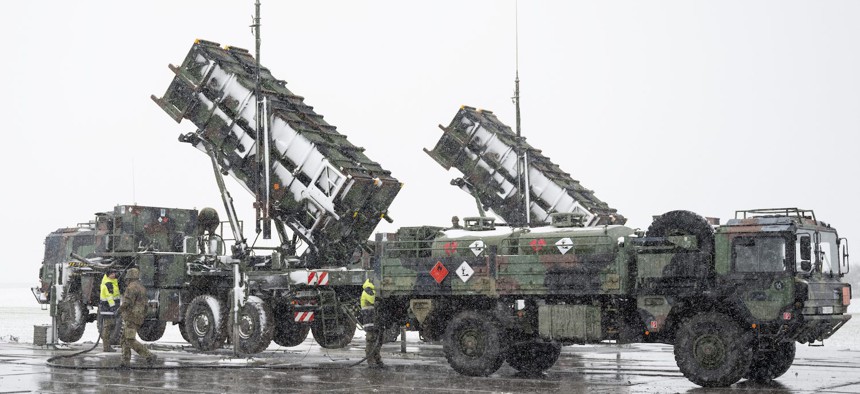
Two trailers with Patriot air defense system launchers at a refueling facility in southeastern Poland in 2023. Sebastian Kahnert / picture alliance via Getty Images
US lacks long-term sustainment plan for key Ukraine weapons, Pentagon watchdog says
Getting new Patriot anti-air systems would be “painful,” a Defense Department official said.
The Defense Department transferred Patriot air defense systems and various combat vehicles to Ukraine without a plan to sustain them long-term, which could lead to problems down the road, according to a report by the Pentagon’s watchdog.
While the Defense Department has helped Ukraine with field repairs, it does not have a plan for more complex depot-level maintenance, according to the report published last week.
Additionally, Remote Distribution and Maintenance Center—Ukraine, the Poland-based U.S. maintenance unit supporting Ukraine, has no ability to do Patriot depot-level repair, the report said. The Inspector General recommended that U.S. European Command identify the requirements and facilities that would be necessary to set up depot-level repair.
Being unable to fully maintain the Patriots “increases the risk” that Ukraine may not be able to defend itself from Russia, the report said.
Patriot batteries have so far proved effective against frequent Russian missile attacks on Ukrainian cities. Last summer, Patriot batteries shot down every one of the more than 30 ballistic missiles Russia fired at Kyiv.
However, Russia is nowhere near running out of missiles. Think tank RUSI assessed that Russia has increased missile production and possesses almost 200 Iskandr 9M723 ballistic and 9M727 cruise missiles.
Another problem: It would be very difficult for the U.S. to replace the Patriot systems it gave to Ukraine, the report said. All the Patriot systems given to Ukraine came from U.S. training grounds, and more requests would be “painful” to fulfill, a Defense Department official said in the report.
Patriot systems are in high demand to protect U.S. forces globally. Patriot battery crews have one of the highest deployment rates across the Army.
But there is also no long-term sustainment plan for the 186 Bradleys infantry fighting vehicles, 189 Strykers infantry carrying vehicles, and 31 Abrams tanks the U.S. has transferred to Ukraine, according to a separate Inspector General report.
The U.S. has given Ukraine the spare parts it will need for field-level maintenance until the end of fiscal year 2024, that report said. But weapons systems are “not likely to remain mission capable without sustainment,” the report said.
In both cases, the reason for the lack of a long-term sustainment plan is that the U.S. did not include money for that purpose when it transferred the weapons to Ukraine, and the Defense Department did not provide additional guidance on the issue.
The watchdog’s report compared the lack of depot-level maintenance in Ukraine to the problems faced by Afghanistan’s national army, which remained dependent on U.S. support for maintenance. Afghanistan’s persistent inability to maintain donated equipment was one factor in the military’s loss to the Taliban, the report said, citing a Special Inspector General for Afghanistan Reconstruction report. Other government reports at the time specifically highlighted Afghanistan’s reliance on contracted aviation maintenance.
Other nations have set up facilities capable of repairing significant battle damage. Lithuania repairs German-designed Leopard tanks that have suffered direct hits, while facilities in Poland repairs both Leopard and Soviet-designed tanks. Still, repair times can be lengthy. Tanks sent to Lithuania in October were not ready to run until mid-December, Lithuania’s Defense Ministry stated.



